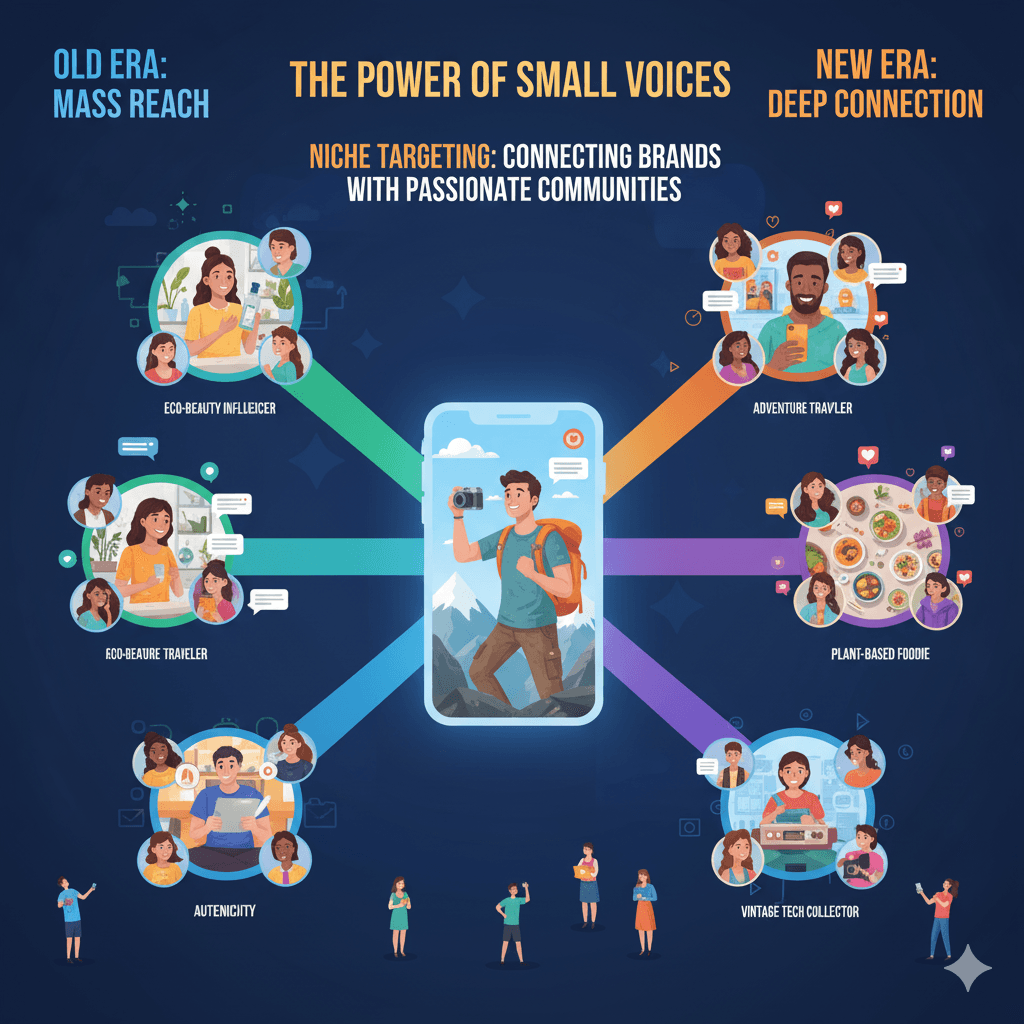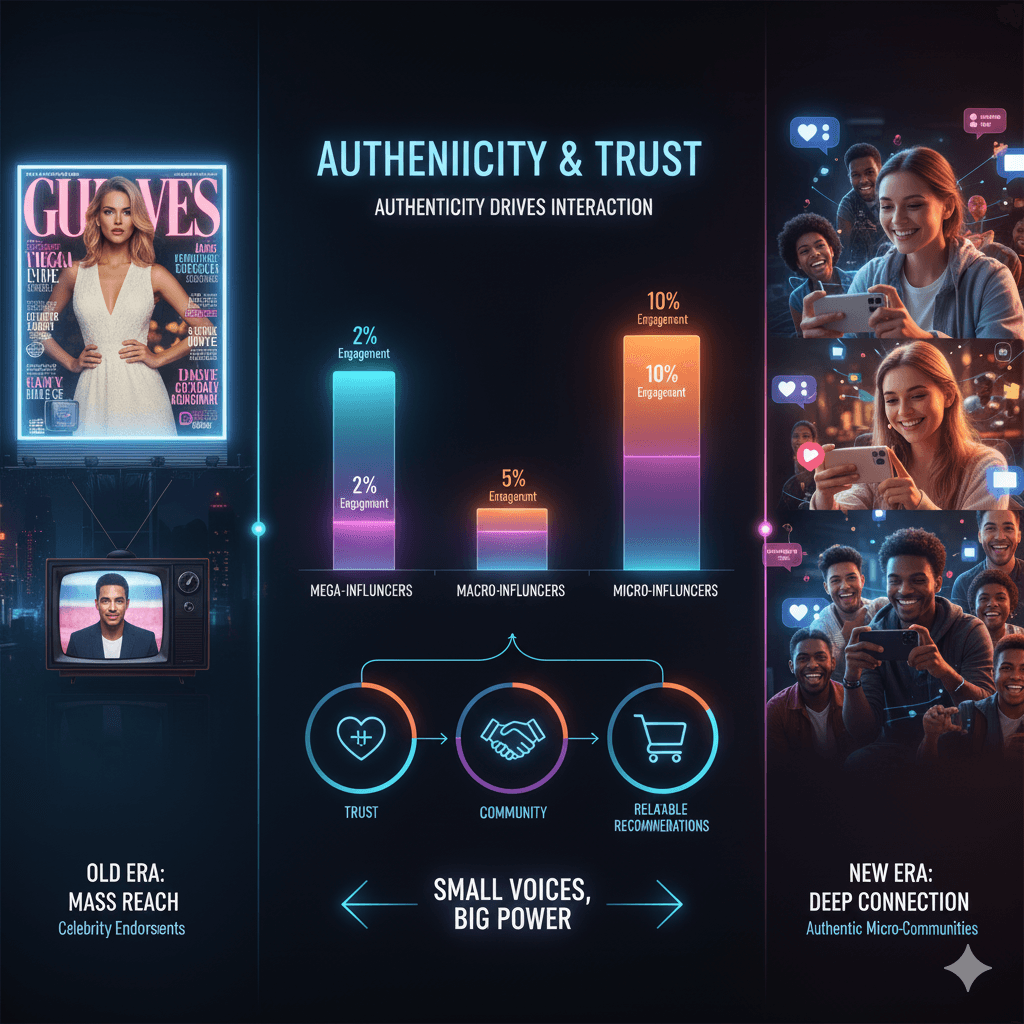The Rise of Everyday Creators: How Small Voices Shape Big Brands
Micro-influencers are reshaping marketing by turning small, niche audiences into powerful brand communities. This article explores how creators with 1,000–100,000 followers drive engagement, build trust, and influence purchasing decisions, showing that authentic connections often have a bigger impact than celebrity endorsements in today’s social media-driven world.

Introduction: The Power of Small Voices
Not long ago, if a brand wanted to sell a product, it relied on big-name celebrities, glossy magazine ads, and prime-time television spots. One supermodel or movie star could influence millions overnight. Fast forward to today, and the game has changed completely.
Now, a social media creator with just 10,000 followers can create more engagement, loyalty, and even direct sales than a celebrity with millions of fans. Welcome to the world of micro-influencers — small voices with big power.
This shift isn’t just about numbers; it’s about trust, authenticity, and niche communities. Brands are learning that real people with real connections often make the biggest impact. This article explores why micro-influencers matter, how brands work with them, and what the future of influencer marketing looks like.
1. What Exactly Is a Micro-Influencer?
In the simplest terms, a micro-influencer is a social media creator who has between 1,000 and 100,000 followers. Unlike mega-celebrities or macro-influencers, micro-influencers tend to focus on specific niches like:
- Beauty and skincare
- Fitness and wellness
- Travel and lifestyle
- Gaming or tech
- Food and beverage
What sets them apart isn’t just follower count; it’s the strength of the connection they have with their audience. Micro-influencers are seen as peers, not distant stars. Their followers trust their opinions because they feel authentic and relatable.
Graf suggestion:
📊 Pie chart of influencer categories: Mega (1M+), Macro (100k–1M), Micro (1k–100k), Nano (<1k).
2. Why Micro-Influencers Are Driving Engagement
Authenticity and Trust
One of the most significant advantages of micro-influencers is authenticity. Followers don’t feel like they’re being sold to; they feel like they’re getting advice from someone they know.
Research shows that micro-influencers often have engagement rates of 2–10%, much higher than mega-influencers, whose followers may be largely passive. That means a smaller audience can generate more meaningful interactions, such as likes, comments, shares, and clicks.
Cost-Effective Marketing
For brands, working with micro-influencers is also budget-friendly. Instead of paying huge sums for celebrity endorsements, companies can collaborate with multiple small creators to reach the same or even better results.
Niche Targeting
Micro-influencers often dominate specific niches, making it easier for brands to reach exactly the right audience. For example:
- A vegan skincare brand might partner with a micro-influencer who posts exclusively about cruelty-free beauty products.
- A boutique travel agency could collaborate with a micro-influencer who shares offbeat destinations.
Graf suggestion:
📈 Bar graph comparing engagement rates: Mega vs Macro vs Micro vs Nano influencers.
3. Platforms That Fuel the Micro-Influencer Trend
Micro-influencers thrive across multiple platforms, each offering unique ways to connect with audiences:
- Stories, Reels, and posts allow micro-influencers to showcase products authentically.
- Features like polls, quizzes, and swipe-ups increase engagement.
TikTok
- Short-form videos allow creativity, humor, and authenticity to shine.
- Even a creator with 5,000 followers can go viral overnight.
YouTube
- Tutorials, reviews, and vlogs let influencers create longer, informative content for niche audiences.
Twitter / X
- Micro-communities, threads, and direct conversations allow real-time engagement with followers.
Graf suggestion:
📊 Pie chart showing platform popularity among micro-influencers.
4. Case Studies: Micro-Influencers Changing the Game
Some of the most successful brands today have leveraged micro-influencers to amplify their reach:
Daniel Wellington
The watch brand famously relied on hundreds of micro-influencers worldwide rather than a few big celebrities. By gifting watches and encouraging posts, they created a sense of personal recommendation that felt genuine.
Glossier
This skincare and beauty brand grew almost entirely through micro-influencer word-of-mouth marketing. Every day users sharing authentic experiences turned into a massive marketing engine.
TikTok Viral Campaigns
- Small creators can turn products into trends overnight.
- Example: A micro-influencer with 15,000 followers posted a creative dance featuring a new snack brand; within 24 hours, the product trended globally.
These examples show that big impact doesn’t require big numbers — it requires authentic engagement.
Graf suggestion:
📊 Bar graph showing ROI of micro vs macro influencer campaigns.
5. How Brands Collaborate with Micro-Influencers
Brands use micro-influencers in several ways:
Sponsored Content
Paying creators to post about products or services, often with guidelines but allowing them creative freedom.
Affiliate Marketing
Give influencers a unique promo code or link to track sales.
Product Seeding & Giveaways
Sending free products to influencers in exchange for honest reviews or content creation.
Long-Term Partnerships
Some brands create brand ambassadors — micro-influencers who promote products consistently over months, fostering credibility and trust.
Tip: Brands succeed when they allow influencers to tell stories naturally instead of pushing sales-heavy messages.

6. The Psychology Behind Micro-Influencer Power
Social Proof
People trust peers more than celebrities. Seeing someone relatable use a product convinces followers it’s worth trying.
FOMO (Fear of Missing Out)
Micro-influencers create tight-knit communities. When a product is popular within that group, followers feel compelled to participate.
Human Connection
Micro-influencers often reply to comments, engage in DMs, and interact personally. This two-way communication strengthens loyalty.
Graf suggestion:
🧠 Infographic showing reasons followers trust micro-influencers more than celebrities.
7. Challenges in Micro-Influencer Marketing
Despite the benefits, working with micro-influencers comes with challenges:
- Finding the right fit: Not all micro-influencers align perfectly with brand values.
- Measuring ROI: Small audiences make tracking impact harder, though tools are improving.
- Fake Followers: Some influencers inflate numbers, which can mislead brands.
- Scaling Campaigns: Managing dozens or hundreds of small creators requires coordination.
Brands must vet influencers carefully and focus on engagement quality over follower count.
8. The Future of Micro-Influencer Marketing
The trend shows no signs of slowing down. Some key directions:
AI Tools
Platforms like Upfluence and AspireIQ help brands discover and manage influencers efficiently.
Nano-Influencers
Creators with under 1,000 followers are gaining attention for ultra-targeted campaigns.
Integration with E-Commerce
Instagram Shop and TikTok Shopping allow micro-influencers to drive direct sales within the app.
Hybrid Campaigns
Brands are mixing micro and macro influencers for maximum reach and engagement.
Graf suggestion:
📊 Timeline infographic showing growth of micro-influencers (2010 → 2025).
9. Real Impact: Why Small Voices Matter
Micro-influencers are not just a marketing fad — they reshape brand perception.
- Followers perceive their recommendations as genuine.
- Engagement is higher and more meaningful.
- Campaigns are cost-effective and scalable.
Brands that embrace micro-influencers wisely can build loyal communities, amplify reach organically, and stay relevant in a noisy digital landscape.
10. Conclusion: Small Voices, Big Changes
In today’s digital-first world, authenticity beats fame. Micro-influencers prove that you don’t need millions of followers to make a real impact.
Their power lies in:
- Niche expertise
- Trustworthiness
- Engagement with real audiences
For brands, ignoring micro-influencers is no longer an option. The rise of these small voices signals a fundamental shift in marketing: it’s not about who shouts the loudest, it’s about who connects the deepest.
As social media continues to evolve, micro-influencers will remain at the heart of brand strategy — showing that small voices can truly shape big brands.
